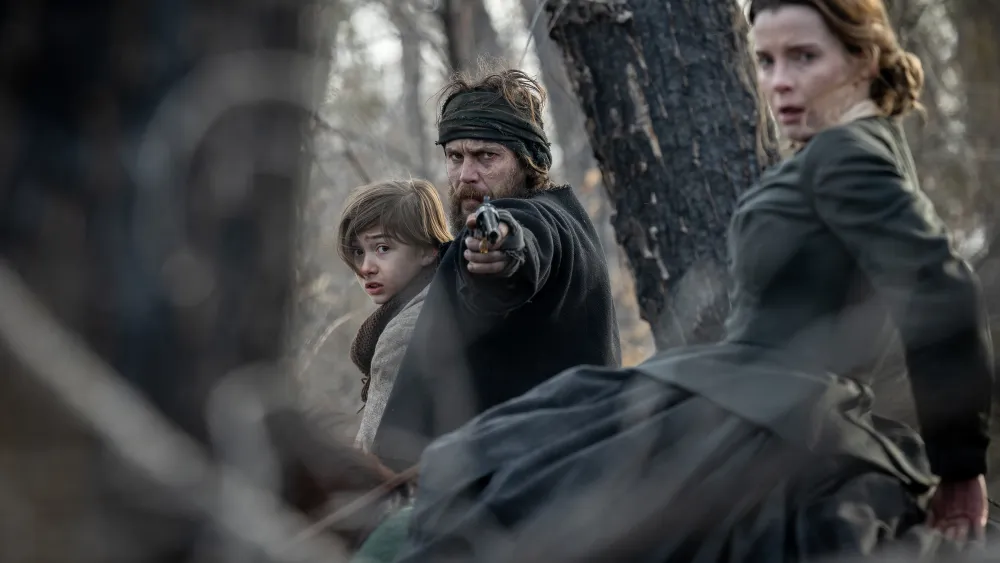In Netflix’s new limited series, “American Primeval,” written by “The Revenant” scribe Mark. L. Smith, audiences are thrust into the viciousness of the American West, specifically the Utah Territory in 1857. Told through the perilous journey of a young mother and her son desperate to start anew, the show examines several groups of Americans — pioneers, Indigenous people, military men and Mormons — all clambering to survive in a profoundly volatile, fear-filled world. The six episodes present a brutal, fascinating depiction of a culture and a country that has yet to overcome its most violent predilections.
This Western begins amid the Utah War, an increasingly bloody conflict between the Church of Jesus Christ of Latter-day Saints — a.k.a. Mormons, led by Utah Governor Brigham Young (an unrecognizable Kim Coates) — and the U.S. Army. A prim and proper but harried woman, Sara Rowell (Betty Gilpin), arrives at a train station with her son, Devin (Preston Mota). Thousands of miles away from their home in Philadelphia, Sara is determined to keep heading westward to meet Devin’s father in the California town of Crook Springs. Unfortunately, having arrived three weeks late due to unreliable train schedules, the pair learn their arranged escort has left. Moreover, when they arrive at Fort Bridger, run by mountaineer Jim Bridger (Shea Whigham), Sara can’t find anyone willing to chaperone them to their destination.
The trek to Crook Springs, which consists of a snowy mountain passage, escalating conflict between the Mormons and the Shoshone tribe and vast areas of unpredictable wildlife and outlaws, isn’t something most men are willing to contend with, despite Sara’s generous financial incentive. Resolved to continue on her trip for the sake of her son, Sara finds herself in a perilous situation, and is forced to lean on the elusive Issac Reed (Taylor Kitsch), a gruff recluse who lives on the outskirts of Ft. Bridger. Issac is an enigma of a man with a deep understanding of the region and its inhabitants. Despite his initial hostility, the mystery of his past slowly reveals itself as the story progresses.
Directed by Peter Berg, “American Primeval” is a truly immersive experience. Through low-angle and tracking shots and exceptional on-location cinematography led by Jacques Jouffret, the audience is shown various points of view. Every single scene is profoundly detailed and intense. Blood is seen pouring out of skinned animals, the near-constant cruelty of the state’s differing climates is apparent and the ruthless, murderous human beings driven by capitalism and colonialism are lethal. It’s also clear that nearly everyone, including Sara, has some ulterior motive.
Though Sara’s voyage is the show’s central focus, the series presents other characters on their own distinct journeys. Mercurial, vengeful and fixated on forming a safe space for Mormons, Brigham Young stops at nothing to see his dream realized. Jacob (Dane DeHaan) and Abish Pratt (Saura Lightfoot Leon), a newly married Mormon couple headed toward Salt Lake City, cross paths with Sara and Devin. Additionally, the narrative highlights the Shoshone tribe who have watched their land and people be ravaged by white settlers claiming it as their own without regard for centuries of culture and tradition. Helmed by Julie O’Keefe, the Head of the Indigenous Cultural Department, the artisans behind “American Primeval” showcase the differences in tribes. There is the Paiute tribe, which has a different outlook on the colonizers than the Shoshone. The audience is also introduced to Red Feather (Derek Hinkey), who leads a more radical faction of the Shoshone called the Wolf Clan. He is fixated on exacting revenge on Army men and Mormons alike.
America is not yet two and a half centuries old. Because it’s still in its infancy, the country’s growing pains are continually evident, and the echoes of history remain ever-present. Westerns are typically presented from the purview of men, and those perspectives are evident here. Yet, in anchoring Sara in the middle of this narrative as well as presenting the viewpoints of Two Moons (Shawnee Pourier), a non-verbal Indigenous girl, and Abish, who was forced to marry Jacob only after her sister died, “American Primeval” acknowledges how deeply the fate of women during this time is tied to the whims, mistakes and desires of the men surrounding them. Furthermore, the constant threat of sexual violence (though thankfully not explicitly shown here) showcases yet another element of terror they endure.
The story of “American Primeval” takes place in less than a two-week period. Still, the ramifications for those who lived and moved across the Utah territory during this time echo throughout American history. The series offers a handful of perspectives, but many more remain buried and unknown. What does ring true until the final frame of the show and into our present-day lives is that civilization and the civilized rarely occupy the same space.
“American Primeval” premieres on Netflix Jan. 9.


